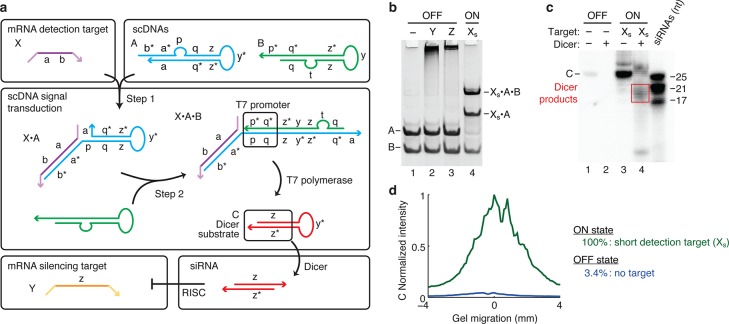Figure 6.
Conditional shRNA transcription using scDNAs. (a) Mechanism 5. scDNA A detects mRNA detection target X (containing subsequence ‘a-b’) and assembles with B to form a transcription template (containing promoter, coding, and termination sequences), leading to transcription of the shRNA Dicer substrate C targeting mRNA silencing target Y (containing independent subsequence ‘z’). scDNAs A and B coexist metastably in the absence of X. X assembles with A via toehold-mediated 3-way branch migration (step 1). Subsequently, X·A assembles with B via toehold-mediated 4-way branch migration to produce a dsDNA transcription template (step 2), mediating transcription of shRNA Dicer substrate C with catalytic turnover. Domain lengths: |a| = 10, |b| = 8, |p| = 8, |q| = 9, |t| = 7, |y| = 6, |z| = 19. (b) Conditional transcription template formation. OFF state: minimal production of transcription template A·B in the absence of short DNA detection target Xs (‘a-b’), the presence of mRNA silencing target Y, or the presence of mRNA off-target Z. ON state: strong production of transcription template Xs·A·B in the presence of Xs. (c) Conditional Dicer substrate transcription and processing. OFF state: minimal transcription of Dicer substrate C in the absence of short DNA detection target Xs (lane 1). ON state: strong transcription of C in the presence of Xs (lane 3) and efficient Dicer processing of shRNA Dicer substrate C (lane 4). (d) Quantification of the Dicer substrate band (C) in lanes 1 and 3 of panel (c). See Section S6 for additional computational and experimental studies of Mechanism 5.

